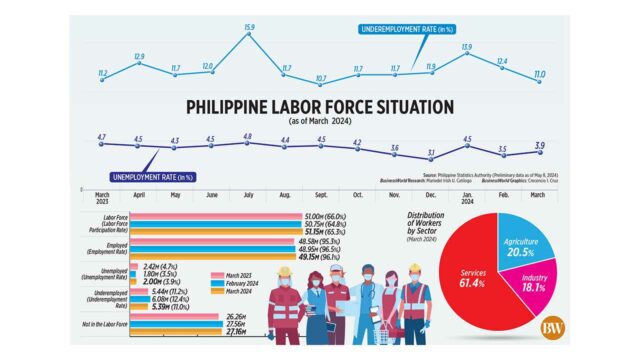MOTHER’S DAY is on Sunday (May 12) and we made a list of things you can do together at some of the country’s best properties. We also included a couple of sweet treats you can buy for celebrations at home.
City of Dreams Manila spoils moms
City of Dreams Manila unwraps thoughtful offerings in appreciation of moms on their special day. Crystal Dragon offers Mother’s Day exclusive ala carte dishes available until May 12 for lunch and dinner. Meanwhile, moms who dine at Crystal Dragon on Mother’s Day will receive a complimentary sweet surprise. Over at Nobu Manila, moms will be treated to a celebrity-inspired Saturday and Sunday brunch experience which highlights the new-style Japanese cuisine of world-renowned Chef Nobu Matsuhisa. Not to be missed on Sunday is a lavish spread that includes a carving station consisting of roasted whole US Prime Ribeye, Smoked Beef Brisket, and Grilled Tuna Collar; and at the sushi station, fresh slices from a whole salmon. The a la carte selection will also feature new Nobu-style dishes on Mother’s Day, to complement the staple brunch offers and confections. Nobu Manila’s Mother’s Day brunch is priced at P4,388 net per person and Nobu Saturday brunch is at P3,499 net per person. Brunch service is from 11:30 a.m. to 3 p.m. Nobu’s seven-course dinner tasting menu (P8,871.43 net per person) is a perfect choice for a dinner date with mom. The seasonal tasting menu is offered until end of June. Nobu’s dinner service is from 5 to 10 p.m. from Sunday to Thursday and until 11 p.m. on Fridays and Saturdays. At Haliya, City of Dreams Manila’s restaurant specializing on reimagined Filipino cuisine, a colorful celebration of Mother’s Day awaits mom and the family with the Pahiyas Festival special menu. Inspired by the fiesta in Lucban, Quezon, the menu is available for the whole month of May. Haliya is open for dinner from 5 to 11 p.m from Mondays to Fridays, also at lunch on Saturdays and Sundays from 11 a.m onwards. Café Society sweetens the occasion with pastries and confections offered from May 9 to 12. As a special gift to moms, the options include a white chocolate tulip cake, a red box full of colorful handcrafted chocolates, granola-filled chocolate dome, and other Mother’s Day-themed confections. For inquiries, call 8800-8080 or e-mail guestservices@cod-manila.com or visit www.cityofdreamsmanila.com.
Discovery Primea pampers moms
The highlight of Discovery Primea’s Mother’s Day celebration is the Stay In The City Room Package, offering a staycation experience in the heart of Makati. Rates start at P8,500++ per night in a Business Flat. For this special occasion, Flame’s chefs present the Mother’s Day Feast, a set menu highlighted by Roasted US Beef Tenderloin Wellington and a decadent Gianduja Chocolate dessert. The set menu is offered for lunch and dinner on May 12 at P9,500++ for a party of four, with a complimentary glass of sparkling wine for all dining moms. Terazi Spa offers the Holistic Holiday Package, designed to rejuvenate Mom’s body, mind, and spirit, with a choice of a 45-minute Body Scrub, a 45-minute Terazi Signature Massage, and a 45-minute Natural & Organic Facial. This special treatment is available for P6,500 net throughout May. For more information, visit https://bit.ly/PrimeaMothersDay. For inquiries and reservations, call 7955-8888 or e-mail dp.rsvn@discovery.com.ph.
Conrad Manila has gifts, dinners for moms
Every day until May 12, Conrad Manila’s pastry chefs prepare All About Mom Mother’s Day-themed cakes, pastries, and special hampers from Bru Coffee Bar. Cakes start at P1,500 net, while pastries are available from P200 net. The hamper box is priced at P5,000 net, and includes flaky sea salt, assorted dry nuts, red velvet crinkles, chocolate lipsticks, vanilla ganache moisturizer, and raspberry creamer, among others. Spend the weekend of May 11 to 12 for the lunch or dinner buffet at Brasserie on 3 which will feature colorful photo booths and live performances. For every four full-paying guests, mom gets lunch or dinner for free, with a “Love you, Mom” message. Diners can enjoy special meals featuring a themed cake and champagne, at P2,750 net per person for lunch (11 a.m. to 2:30 p.m.) and P3,888 net per person for dinner (6 to 10 p.m.). “Tribute to Mom” is China Blue by Jereme Leung’s specially curated lauriat menu for lunch and dinner on May 11 to 12, celebrated with the whole family. Priced at P49,888 net, this set menu good for 10 persons. Special mocktail drinks may be shared among four dining family members. Party packages set menu are also available for takeaways at lunch or dinner. At C Lounge, from May 6 to 12, spoil mom with a Mother’s Day-themed afternoon tea for P3,606 net. There are also Mother’s Day spa experiences, offering 90 minutes and 120 minutes of pure relaxation using ESPA product. Rates start at P7,500 nett. A weekend or overnight get-away at one of Conrad Manila’s rooms overlooking Manila Bay or the city view comes with a breakfast buffet for two at Brasserie on 3. For inquiries, call 8833-9999, e-mail conradmanila@conradhotels.com or visit https://eatdrinkhilton.com/brasserie-on-3-conrad-manila/.
Mother’s Day treats at Newport World Resorts
Casa Buenas at the Newport Grand Wing offers the Dulce Reina Mother’s Day menu, available throughout the month of May for P5,500 net. Highlights are Grilled Wrapped Barramundi, Roasted Herb Pork Loin with Chorizo Stuffing, and Roasted Pulpo and Tomato Salad among other savory dishes, with Strawberry Shortcake for dessert. Over at the Garden Wing Cafe at the Newport Garden Wing, a Mother’s Day special Afternoon Tea is served for P1,500 net for two persons. At Hotel Okura Manila, for Mother’s Day on May 12, the buffet at Yawaragi (P3,950++ per person) comes with a complimentary glass of Shinomine Junmai Daiginjo Aiyama Sake for mom. Yamazato Japanese Fine Dining restaurant offers a Mother’s Day Obento Kaiseki exclusively available for lunch and dinner on May 11 and 12. For P3,500++ per person, the meal is highlighted by the sustainable Filipino Maya-Maya. Mothers receive an extra treat in the form of one flight of Yamazato’s Natsu Sake Selection. Hilton Manila is serving Mama’s Fine Feast for brunch at the Kusina Sea Kitchens (with free-flowing Barefoot Pink Moscato) on Mother’s Day for P2,800++ per person. At the Madison Lounge and Bar, grab a few sweet treats like the Duo Chocolate Brownie Fudge Whole Cake for P2,500++ and Flower Mango Cream Whole Cake for P2,900++ or a box of Chocolate Roses and Pralines for P888++.
Meanwhile, the Marriott Manila has a limited-edition “HERitage Gift” from the Marriott Cafe Bakery for every dining and retail purchase worth P2,000 to P4,000 throughout the month. The special offer is exclusive to members of Club Marriott, Marriott Bonvoy, and Newport World Resorts. Sheraton Manila’s S Kitchen has a Mother’s Day lunch for P3,880 net per person, which includes photo souvenirs for families. At the Holiday Inn Express Manila-Newport City, Mother’s Day is an overnight affair in a Standard Room with breakfast for two (kids below 12 years old stay and eat breakfast for free). For P4,900 net, the package includes welcome drinks for two, a P1,000 hotel F&B voucher, and a gift. At the Newport Mall, a French Quintet will be serenading families at The Plaza while sketch artists offer live portrait sketches amid flower store pop-ups on May 12. Swarovski, Furla, Pandora and other premium retail stores will offer special Mother’s Day specials. For more information on Mother’s Day offers from Newport World Resorts, visit www.newportworldresorts.com and follow @newportworldresorts on Facebook and Instagram, and @nwresorts on Twitter.
May is for Mothers at Marco Polo Ortigas Manila
Marco Polo Ortigas’ Lung Hin restaurant has created a 10-dish Lauriat feast to celebrate mothers. From May 1 to 12, groups of five and 10 will enjoy an authentic Cantonese banquet. On Sunday, May 12, the hotel’s all-day dining restaurant, Cucina showcases Asia’s best dishes. Children below seven years old dine free of charge. For reservations, call 7720-7777.
Richmonde Hotels’ adventure for moms
The Richmonde Hotels in Ortigas, Eastwood and Iloilo have prepared to welcome all mothers with a lineup of treats in celebration this May. At the Ortigas branch, let mom pick any day in May to have a staycation and she’ll get a petite Mother’s Day cake, a Richmonde neck pillow, Sampaguita smoothies good for two, and a 15% discount on in-room massage services, and along with regular amenities including the heated indoor pool. Rates start at P4,200 net (room only) and P5,200 net (with breakfast buffet for two) and are valid until May 31. Richmonde Ortigas’ Richmonde Café serves up a Feast for Mom at the Mother’s Day Lunch Buffet from 11:30 a.m. to 2:30 p.m. The buffet is priced at P1,785 net, inclusive of one round of mimosa, and coffee or tea, plus a token for mom. Children six to 12 years old get 50% discount and those five years and below eat for free. At Eastwood, check out the summer staycation package with breakfast buffet for two adults and two children five years old and below, welcome drinks for two at Eastwood Café+Bar (choice of coffee, tea, or iced tea), a 20% discount on food and beverage orders, use of the gym and swimming pool, and, just for mom, an in-room body massage, all for P5,800 net. This promotion is available for stays from May 10 to 13. Eastwood Café+Bar brings a Feast from the Sea for mom on its Mother’s Day Buffet, available for lunch from 11:30 a.m. to 2:30 p.m., and dinner from 6 to 10 p.m., for P1,799 net inclusive of bottomless iced tea and coffee or tea. Children six to 12 years old get 50% off while those five and below eat free. Mom also gets to dine for free with the 4+1 Deal where if four persons at the table pay the full price, mom’s buffet is on the house. At Iloilo, the Wonders of Wellness Room Package is available. That includes accommodations in a spacious room; a choice of a Moroccan full body massage, aromatherapy, Ventosa, head and back massage or head and foot massage for mom; a 10% discount on additional massage and wellness services; and use of the hotel’s gym and pool. A buffet breakfast for two at The Granary, and a serving good for two of the hotel’s signature All Day Treats are also part of the package. Rates start at P7,275 net. There are also the Waves of Wanderlust Room and Cruise Packages where mom and the family get to see a different side of Iloilo City via an exclusive boat tour and relish the comforts of Richmonde at the same time. Mom’s Sunset Cruise includes a view of the sunset along Guimaras Strait from 4 to 7 p.m. and is priced at P30,000 net. A nighttime city tour along Iloilo River from 7:30 to 10:30 p.m. is also available, priced at P27,400 net. Both packages include the following: overnight stay in two Deluxe rooms for a maximum of two adults and two children 12 years old and below per room, breakfast buffet for two adults and two children five years old and below, 50% discount on buffet breakfast for children six to 12 years of age, van transfers from the hotel to The Boat Club and vice versa, charter cruise good for a maximum of 10 persons with refreshments (non-alcoholic). For additional room bookings, the special rate of P5,300 for a Deluxe room with breakfast may be applied. On Sunday, May 12, at Richmonde Iloilo’s The Granary will serve a dinner buffet filled with global cuisine. To add to the fun, MOMosas (mimosas) and other refreshments will be served at the Mother’s Day Dinner Buffet, which is priced at P1,650 net. Children six to 12 years old get half off the buffet rate and toddlers five years and below eat for free. Contact Richmonde Hotel Ortigas via 8638-7777, 0917-859-7914 or e-mail stay@richmondeortigas.com; for Eastwood Richmonde Hotel, call 8570-7777 or 0917-521-6867 or e-mail stay@eastwoodrichmonde.com; and for Richmonde Hotel Iloilo, call (6333) 328-7888 or 0917-580-9642 or e-mail stay@richmondeiloilo.com.
Pizza Hut melts mother’s hearts
Pizza Hut made Melts for dessert, with three flavors to choose from. First is the new KitKat Melt, a cheesy and chocolatey treat made with a dollop of KitKat Spread, KitKat pieces, marshmallows, and stretchy mozzarella cheese, all folded into a thin, crispy wrap and finished with powdered sugar sprinkle. The second is the Ube Cheese Melt, made with ube halaya (purple yam jam), cheddar cheese, marshmallows, and mozzarella cheese, also encased in a thin and crispy wrap and then sprinkled with powdered sugar. Finally, there’s the Apple Cinnamon Melt, also in a wrap, with apple filling, cinnamon sugar, marshmallows, and mozzarella cheese. All three Sweet Melts flavors come with a milk dip. There is also an option to top the Melts with a scoop of ice cream (available in select stores only). The new Sweet Melts flavors start at P199 and are available for dine-in and takeout orders in all branches nationwide, and for delivery via the 8911-1111 hotline, www.pizzahut.com.ph, the Pizza Hut mobile app, and Pizza Hut’s official delivery partners GrabFood and foodpanda (prices may vary).
A cake for every mom at Red Ribbon
Red Ribbon’s Specialty Cakes offer a selection of cakes to match every mom’s taste on Mother’s Day. There is Black Forest Cake, a rich chocolate fudge cake with creamy icing, cherry filling, a coating of grated chocolate and chocolate square toppings. The new Caramel Delight Cake features caramel icing inside and out. Then there are the Ube Bloom Cake and the Chocolate Heaven Cake. Visit a Red Ribbon store or order online at order.redribbon.ph, the Red Ribbon App, or the GrabFood and foodpanda.
Free ice cream and more at Mang Inasal
From May 1 to 12, mothers can enjoy the “Treat kay Mommy” Promo at all Mang Inasal stores nationwide. Customers can get free extra ice cream scoop for every purchase of Extra Creamy Halo-Halo Regular Size. The promo can be enjoyed via dine-in, takeout, and delivery. There is also the Mother’s Day Fiesta Treat, which can be enjoyed via takeout and delivery. From May 10 to 12, families can enjoy a special Family Fiesta bundle that comes with four Extra Creamy Halo-Halo 8 oz. Add-On and four drinks small size. Mother’s Day Fiesta Treat can be availed via https://manginasaldelivery.com.ph, Mang Inasal Delivery App, GrabFood and foodpanda.

























